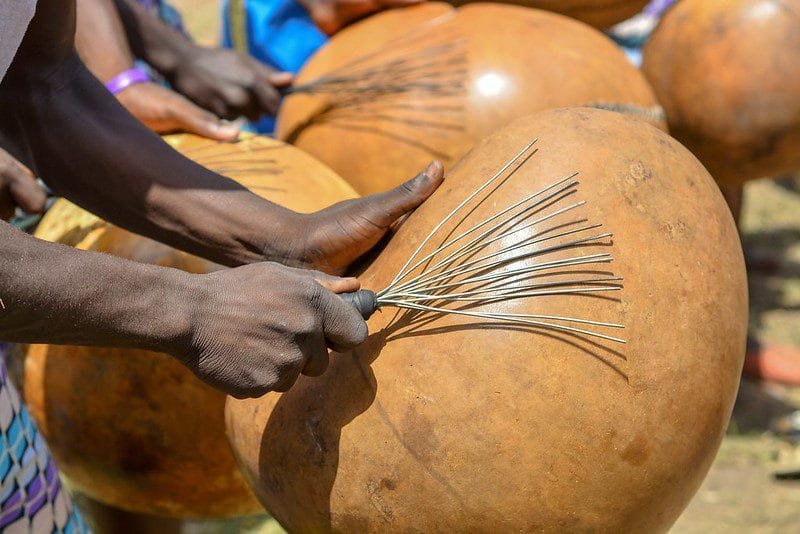
INTERNATIONAL
info@allinafricasafaris.com
INTERNATIONAL, 24/7 Help Support
USA/CANADA | M-F 9:00 am - 5:00 pm

The Tribes of Uganda: Known as the Pearl of Africa, Uganda is home to a variety of stunning natural resources, including hills, valleys, mountains, plants, and water. The lovely people of Uganda look after and surround all of the aforementioned treasures.
Although Uganda lacks a coastline due to its landlocked status, it has borders with South Sudan to the north, Rwanda and Tanzania to the south, Kenya to the east, and the Democratic Republic of the Congo to the west. Finding out that Uganda’s amazing neighbors share some of the same tribes and languages is astounding.
With more than 56 tribes and more than 60 languages spoken, Uganda is endowed with amazing and welcoming people. These tribes come from its major ethnic groupings, which include the Nilotes, which have tribes like the Acholi, Langi, Alur, Itesots, and Karamojong, and the Bantu, which has tribes like the Baganda, Basogo, Bagishu, Banyankole, Banyoro, Bakiga, and others. The Kakuwa, Lendu, and Bari belong to the Nilo Hamites. In addition to the Pygmies, which include the Batwa people of far western Uganda, the Hamites also include the Bahima, Tutsi, and Hutu.
The Baganda tribe primarily inhabits central Uganda, where Kampala, the country’s capital, is located. These individuals belong to the Bantu ethnic group, which is Uganda’s largest ethnic tribe. They are said to have moved to the central and western regions of Uganda thousands of years ago from the southwestern region of Africa around the Niger River.
Under the leadership of their king, known as the Kabaka, the Baganda people are also the most organized tribe in Uganda. Kabaka Muwenda Mutebi II is the name of the Kabaka in existence today. Because it has a palace and a parliament, the Buganda Kingdom is structured.
The four deceased former monarchs were interred in the Kasubi tombs, a UNESCO-accredited world historic site. One can take a royal tomb tour at Kasubi tomb while in the Central Region of Uganda. Speaking the Luganda language, the Baganda people have many folk songs about food, alcohol, fishing, death, women, and children, as well as educational songs.
Their most popular traditional dances are Bakisimba, Muwogola, and Nankasa. There are many folktales that will make a Ugandan culture tour in Buganda Kingdom truly complete. The Baganda have been able to maintain and modernize their rich cultural heritage. To name a few districts, the Baganda tribe includes Kampala, Mukono, Sembabule, Masaka, Luwero, Mubende, Mpigi, Rakai, Kalangala, Kiboga, and Wakiso.
Known as the Busoga Region, the eastern section of Uganda is home to the Basoga tribe, a Bantu group that includes the districts of Jinja, Kamuli, Bugiri, Iganga, Namayingo, Mayuge, Luuka, Namutumba, Kaliro, Bugweri, and Buyende. The Kyabazinga of Busoga is the king who rules over the entire Busoga region.
He is William Wilberforce Kadhumbula Gabula Nadiope IV, the Kyabazinga of Busoga today. Lusoga is the name of the language used by the Basoga people. The Basoga Kingdom is located near Jinja, a popular tourist destination with a wealth of attractions. After visiting the Busoga kingdom and learning about its history, myths, and beautiful traditional dance and songs, as well as the Railway Museum, one can add exciting and fun activities to a Uganda cultural tour or safari.
These include, but are not limited to, white water rafting at Bujagali Falls, visiting the Nile’s source and Speke monument, bungee jumping, zip lining, horseback riding along the Nile’s shores, sport fishing, and birdwatching along the river’s shores. To name a few, one can also visit the several fish landing locations in the area, such as Masese, the sugar plantations, and the factories.
Located in the western region of Uganda, the Batoro tribe is one of the organized tribes and belongs to the Bantu ethnic group. Fort Portal, located in Kabarole, is the Batoro’s principal town. This Ugandan tribe is renowned for its well-behaved and attractive females. The Toro kingdom, which is led by the King, is the umbrella under which the Batoro are arranged.
Known locally as Omukama, King Oyo Nyimba Kabamba Iguru Rukidi IV has ruled Toro Kingdom as Omukama for the past three and a half years. The kingdom is situated in the center of Port Portal, a popular tourist destination, and the Batooro culture has a long and varied history.
Amabere Ga Nyina Mwiru, Tooro Kingdom, Village Walks, Semuliki National Park, Sempaya Hot Springs, and hiking are just a few of the stunning cultural sites that may be visited at Fort Portal during a Uganda cultural trip. The Batooro people have lovely traditional songs and dances called Entogoro or Orunyege. The districts of Kabarole, Kyenjojo, Kyegegwa, Kitagwenda, Kamwenge, Kasese, and Ntoroko are home to the majority of the Batoro people.
The tribe is a Bantu ethnic group that lives in the southwest region of Uganda. Ugandans refer to them as Westerners. They are well-known for raising cattle, particularly dairy cattle and the uncommon long-horned Ankole breed. Because they are voluptuous, attractive, and have wonderful skin, Banyankole ladies are renowned for their beauty.
Although the Banyankole are not formally organized as a kingdom, they are a friendly, helpful group of people who help one another out as fellow tribe members. They have lovely traditional dances called Ekitaguriro dances, speak the Runyankole language, and dress in busuti for men and mushanana for women.






